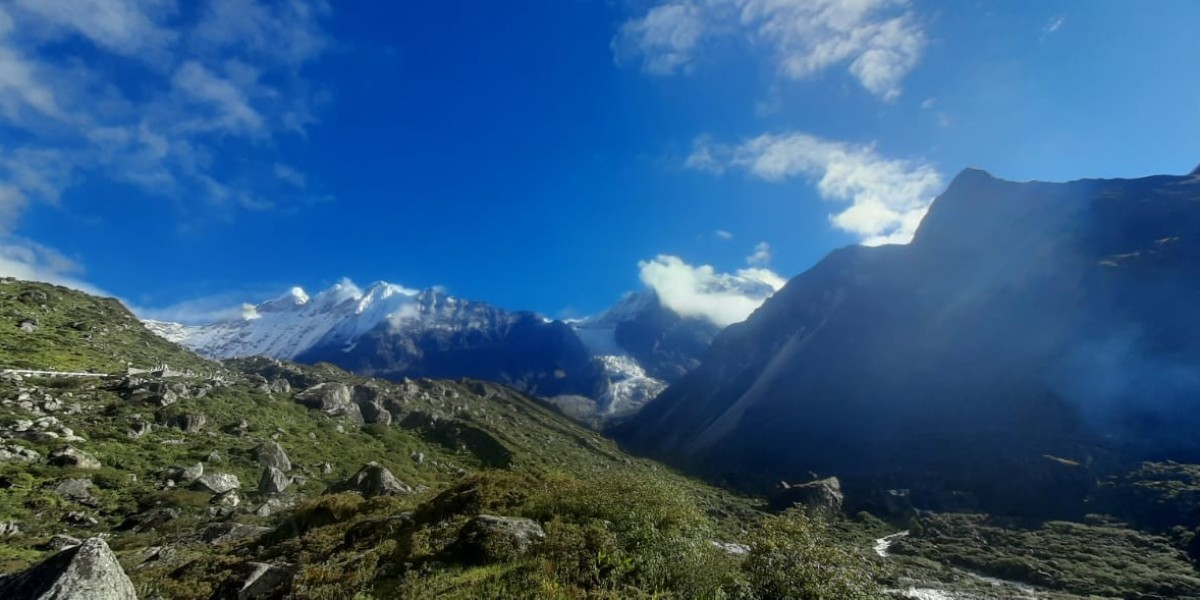Nestled in the shadow of the majestic Manaslu, the eighth highest mountain in the world, this trek takes adventurers through a remote and less-traveled part of the Himalayas, providing a unique blend of natural beauty and cultural immersion.
The Manaslu Circuit Trek begins in the lush lower foothills, where trekkers traverse terraced fields and quaint villages that offer glimpses into traditional Nepali life. As the trek progresses, the landscape transforms dramatically, ascending through dense forests of oak and rhododendron, and eventually opening up to high-altitude alpine meadows and rugged terrain. The path follows ancient trade routes that have connected Nepal with Tibet for centuries, adding a historical dimension to the trek.
One of the circuit’s highlights is the crossing of the Larkya La Pass, situated at 5,106 meters (16,752 feet). This high-altitude pass is the trek’s crowning achievement and provides panoramic views of some of the region’s most impressive peaks, including Manaslu, Annapurna, and Ganesh Himal. The ascent to Larkya La is challenging and requires careful acclimatization, but the reward is a breathtaking view that captures the raw beauty of the Himalayas.
Throughout the trek, the Manaslu Tsum Valley Trek offers a blend of cultural and natural wonders. Villages like Samagaon and Samdo are traditional Tibetan settlements where trekkers can explore ancient monasteries, interact with local communities, and experience the unique cultural practices of the Tibetan people. These villages provide a window into a way of life that has remained relatively unchanged for centuries.
The circuit also passes through diverse ecosystems, from subtropical forests to alpine tundra, and features numerous suspension bridges, cascading waterfalls, and glacial rivers. The trek’s remote nature means that it remains less frequented by tourists compared to other popular routes like the Annapurna Circuit or Everest Base Camp, allowing for a more serene and immersive experience.
Trekking the Manaslu Circuit requires a combination of physical stamina, proper acclimatization, and preparation due to its remote and challenging nature. However, those who undertake this journey are rewarded with an unparalleled adventure that combines dramatic landscapes, cultural richness, and the sense of discovering a hidden gem in the Himalayas.
Introduction
The Manaslu Circuit offers a journey through one of Nepal's most pristine and secluded trekking routes, promising an adventure off the beaten path. Located in the Gorkha district, this trek encircles the majestic Manaslu, the eighth highest mountain in the world, providing trekkers with a blend of breathtaking natural beauty and rich cultural experiences. Unlike the more frequented Annapurna or Everest circuits, the Manaslu Circuit remains relatively untouched by mass tourism, allowing adventurers to explore serene landscapes and traditional villages with fewer crowds. The trek combines challenging terrain with stunning vistas of snow-capped peaks, deep valleys, and lush forests. It also offers a unique opportunity to immerse oneself in the local culture of Tibetan-influenced communities. As trekkers traverse through remote areas, they encounter ancient monasteries, vibrant local traditions, and diverse ecosystems. With its remote setting and high-altitude passes, the Manaslu Circuit is ideal for those seeking a true Himalayan adventure that blends natural splendor with cultural richness.
Overview of the Manaslu Circuit
The Manaslu Circuit Trek Food is a captivating trek that loops around the Manaslu massif, spanning approximately 177 kilometers (110 miles) and typically taking around 14 to 18 days to complete. The journey begins in the lush subtropical regions and ascends through a series of diverse landscapes, including dense forests, terraced fields, and alpine meadows. The highlight of the trek is crossing the Larkya La Pass, which stands at 5,106 meters (16,752 feet) and offers panoramic views of the surrounding peaks, including Manaslu, Annapurna, and Ganesh Himal. The trek follows ancient trade routes that have historically connected Nepal with Tibet, providing a rich cultural context to the adventure. Key stops along the route include traditional Tibetan villages like Samagaon and Samdo, where trekkers can experience local customs and visit ancient monasteries. The Manaslu Circuit’s combination of challenging high-altitude trekking, remote beauty, and cultural immersion makes it a distinctive and rewarding journey through the Himalayas.
Preparation and Training
Proper preparation and training are crucial for successfully tackling the Manaslu Circuit Trek itinerary, given its challenging terrain and high-altitude environment. Trekkers should engage in a comprehensive fitness regimen that includes cardiovascular exercises like running, cycling, and hiking to build endurance and stamina. Strength training focused on the legs and core is also beneficial, as the trek involves prolonged hiking over varied and rugged terrain. Prior experience in high-altitude trekking or hiking is advantageous for acclimatization and managing altitude sickness. It is recommended to undertake several multi-day hikes with a loaded backpack to simulate the trek’s conditions. Acclimatization is key, so understanding the trek’s altitude profile and incorporating rest days into your preparation can help your body adjust to higher elevations. Additionally, familiarizing yourself with the trek’s itinerary, weather conditions, and potential challenges will aid in overall preparedness. By combining physical training with thorough research and planning, trekkers can enhance their chances of a successful and enjoyable Manaslu Circuit adventure.
Essential Gear and Packing List
Packing for the Manaslu Circuit requires careful selection of gear to accommodate the trek’s varied conditions. Essential items include a well-fitted trekking backpack, durable trekking boots with good ankle support, and a layered clothing system. The layering system should consist of moisture-wicking base layers, an insulating mid-layer, and a waterproof and windproof outer layer to adapt to changing weather conditions. A high-quality down jacket and a sleeping bag rated for cold temperatures are necessary for high-altitude comfort. Trekking poles can provide stability and reduce strain on knees during descents. Other important gear includes sunglasses with UV protection, a wide-brimmed hat, and high-SPF sunscreen to protect against intense sun exposure. A comprehensive first aid kit, personal medications, and water purification tablets are crucial for health and safety. Additionally, bring a good camera or smartphone to capture the trek’s stunning scenery. Though some gear can be rented in Kathmandu or Pokhara, having your own ensures that it meets your specific needs and enhances your trekking experience.
Permits and Documentation
To 9 Days manaslu Circuit Trek, obtaining the necessary permits and documentation is essential for a smooth journey. The primary permits required are the Manaslu Conservation Area Permit (MCAP) and the Annapurna Conservation Area Permit (ACAP). The MCAP is necessary for entry into the Manaslu Conservation Area, while the ACAP is required for trekking in the Annapurna region. Additionally, trekkers need to secure a Restricted Area Permit (RAP) due to the trek's remote and restricted nature. The RAP is issued by the Department of Immigration in Kathmandu and requires a trekking agency to facilitate the application process. It is important to apply for these permits well in advance, as the process can be time-consuming. A valid passport with at least six months’ validity beyond the trek dates is also required. While many trekking agencies can handle the permit arrangements and provide assistance with additional documentation, it is crucial to confirm all permit requirements and ensure that they are in order before commencing the trek to avoid any issues during your adventure.
Travel Arrangements and Logistics
Embarking on the Manaslu Circuit involves several key travel arrangements and logistical considerations to ensure a smooth and enjoyable trek. The journey typically begins with a flight into Kathmandu, Nepal's bustling capital. From Kathmandu, trekkers usually take a domestic flight to the town of Pokhara, a popular gateway for various treks. However, the Manaslu Circuit starts with a road journey from Kathmandu to Soti Khola, which serves as the trek's starting point. This road trip can be an adventure in itself, as the route winds through mountainous terrain. Arranging transportation from Kathmandu to Soti Khola, as well as back from the trek's end point, is essential. It's advisable to book transportation and accommodations in advance to secure your travel arrangements. Additionally, engaging a reputable trekking agency can streamline logistics by organizing permits, guides, and porters, and handling any unforeseen issues. Given the trek's remote nature, ensuring you have appropriate travel insurance that covers high-altitude trekking and emergency evacuation is also crucial. Proper planning of these travel arrangements and logistics helps set the stage for a successful and hassle-free Manaslu Circuit adventure.
Trekking Route and Itinerary
The Manaslu Circuit Trekking is a captivating trek that covers approximately 177 kilometers (110 miles) and typically takes 14 to 18 days to complete. The trek begins in Soti Khola and follows a well-defined route through a variety of landscapes. The itinerary generally includes daily treks of 5 to 7 hours, with stops at key locations such as Machapuchare Base Camp, Larkya Phedi, and the high-altitude Larkya La Pass. Each day offers a mix of challenging ascents, scenic descents, and cultural encounters. Key segments of the route include the lush subtropical forests and terraced fields of the lower regions, the Tibetan-influenced villages of Samagaon and Samdo, and the dramatic alpine scenery as you approach the Larkya La Pass. The crossing of Larkya La, at 5,106 meters (16,752 feet), is the trek’s highlight, offering stunning views of the surrounding Himalayan peaks. The descent through the remote, less-traveled areas provides a serene contrast to the more popular trekking routes. The itinerary is designed to allow for acclimatization and cultural immersion, balancing physical challenges with opportunities to experience the region’s natural and cultural richness.
Key Highlights and Scenic Spots
The Manaslu Circuit is renowned for its dramatic landscapes and key scenic highlights that make the trek truly memorable. One of the standout features is the breathtaking views from Larkya La Pass, which offers panoramic vistas of the Manaslu massif, Ganesh Himal, and Annapurna ranges. The trek passes through a series of scenic spots, including lush forests of oak and rhododendron, terraced fields, and traditional Tibetan villages. The serene village of Samagaon, situated at the foot of Manaslu, provides stunning views of the mountain and a chance to explore ancient monasteries and local culture. The trek also features numerous suspension bridges, cascading waterfalls, and glacial rivers that enhance the natural beauty of the route. The diverse ecosystems encountered along the way, from subtropical lowlands to alpine meadows, offer a dynamic range of landscapes. Additionally, the remote and less-traveled nature of the trek allows for a sense of solitude and connection with the pristine environment, making the Manaslu Circuit a visually and emotionally rewarding journey.
Cultural and Local Insights
The Short Manaslu Circuit Trek is not only a trek through stunning landscapes but also an immersion into the rich cultural tapestry of the region. The trek traverses through traditional Tibetan-influenced villages where trekkers can engage with local communities and learn about their way of life. Villages such as Samagaon and Samdo are notable for their Tibetan-style architecture, ancient monasteries, and traditional customs. These settlements offer a glimpse into the unique cultural practices of the Tibetan people, including their religious rituals and traditional crafts. Interacting with local residents provides insights into their daily lives, which remain largely unchanged despite modern influences. The circuit also follows ancient trade routes that historically connected Nepal with Tibet, adding a historical dimension to the cultural experience. Festivals, local cuisine, and traditional music are integral parts of the cultural experience along the trek. Respecting local customs and engaging with the community enriches the trekking experience, offering a deeper understanding of the region's cultural heritage and fostering a connection with the people who inhabit these remote Himalayan valleys.
Altitude and Acclimatization
Altitude and acclimatization are critical factors for successfully completing the Manaslu Circuit Trek Guide, given its high-altitude terrain and challenging elevations. The trek reaches its highest point at Larkya La Pass, which stands at 5,106 meters (16,752 feet). Proper acclimatization is essential to avoid altitude sickness and ensure a safe trekking experience. The trek’s itinerary is designed to facilitate gradual acclimatization by incorporating rest days and gradual ascents. Key acclimatization points include spending extra days in villages such as Samagaon and Samdo, which allows trekkers to adapt to the increasing altitude. Symptoms of altitude sickness, including headaches, dizziness, and nausea, should be monitored closely, and descending to a lower altitude may be necessary if symptoms persist. It is advisable to ascend slowly, stay hydrated, and avoid overexertion. Preparing for altitude challenges involves physical training and acclimatization strategies before the trek, such as hiking at higher elevations if possible. By adhering to these acclimatization practices and listening to your body, you can manage altitude-related challenges and fully enjoy the spectacular and remote beauty of the Manaslu Circuit.
Daily Schedule and Trekking Experience
The Manaslu Circuit trek is meticulously structured to provide an immersive and well-paced adventure through diverse landscapes and cultural settings. The daily schedule typically involves early starts, with trekkers setting off around 7-8 AM to make the most of daylight and reach their destinations by mid-afternoon. Each day generally includes 5 to 7 hours of trekking, covering distances of 10 to 15 kilometers, depending on the terrain and elevation gain.
The trek begins with a gradual ascent through terraced fields and forested trails, gradually increasing in difficulty as the altitude rises. Notable days include the challenging ascent to the Larkya La Pass, which is tackled in a single day from Larkya Phedi, typically starting early in the morning to avoid potential weather issues at the pass. Trekkers experience varying terrain each day, from lush subtropical forests and charming villages to arid high-altitude landscapes.
Key experiences include interactions with local communities in Tibetan-influenced villages like Samagaon and Samdo, where trekkers can explore ancient monasteries and traditional lifestyles. The trek also offers stunning views of the Manaslu massif, Ganesh Himal, and Annapurna ranges, with rest days and acclimatization stops strategically placed to ensure proper adjustment to the altitude. The daily itinerary is designed to balance physical exertion with opportunities to appreciate the region's natural beauty and cultural richness, making for a rewarding trekking experience.
Accommodations and Meals
Accommodations on the Manaslu Base Camp primarily consist of teahouses, which provide basic yet comfortable lodging along the route. These teahouses offer private or shared rooms with essential amenities such as beds, blankets, and common areas for dining and relaxation. While the standard of accommodations varies, they generally offer a welcoming environment with warm hospitality from local hosts.
Meals are served at the teahouses and typically include a variety of traditional Nepali and Tibetan dishes. Breakfasts often feature items like eggs, toast, and porridge, while dinners include hearty options such as dal bhat (rice with lentil soup), momo (dumplings), and noodle soups. As trekkers ascend to higher altitudes, the variety of food may become more limited, but the emphasis remains on providing nutritious and satisfying meals to fuel the trek. It's advisable to bring some high-energy snacks to supplement the teahouse meals. The communal dining areas also provide opportunities to meet fellow trekkers and share experiences, adding a social element to the trekking journey.
Weather and Climate Considerations
Weather and climate conditions on the Manaslu Tsum Valley Trek can vary greatly due to the trek's diverse elevations and geographical locations. The best times to undertake the trek are during the pre-monsoon (March to May) and post-monsoon (September to November) seasons. During these periods, weather conditions are generally stable with clear skies and moderate temperatures, providing optimal trekking conditions.
Daytime temperatures in the lower elevations are usually mild, ranging from 10°C to 15°C (50°F to 59°F), but temperatures can drop significantly at higher altitudes, particularly at the Larkya La Pass where it can be below freezing. Trekkers should be prepared for rapid weather changes, including potential snow, rain, and strong winds. Packing appropriate gear, such as layers of clothing, waterproof and windproof jackets, and insulated sleeping bags, is essential for handling these conditions. Monitoring weather forecasts and being flexible with trekking plans can help manage weather-related challenges and ensure a more comfortable trekking experience.
Health and Safety Precautions
Health and safety are paramount on the Short Manaslu Circuit due to the trek's high-altitude nature and physical demands. The trek reaches elevations of up to 5,106 meters (16,752 feet) at Larkya La Pass, making acclimatization crucial. Proper acclimatization involves a gradual ascent with planned rest days to allow your body to adjust to higher altitudes. Key symptoms of altitude sickness include headaches, nausea, and dizziness. If these symptoms occur, it's important to descend to a lower altitude and seek medical attention if necessary.
Travel insurance that covers high-altitude trekking and emergency evacuation is highly recommended. A well-equipped first aid kit, including personal medications, altitude sickness tablets, and water purification supplies, is essential for addressing health issues. Good hygiene practices, such as using purified water and avoiding undercooked food, help prevent gastrointestinal problems. Staying hydrated, eating well, and pacing yourself during the trek are important for maintaining overall health and safety. By adhering to these precautions and listening to your body, you can mitigate health risks and enjoy a safer trekking experience.
Tips for a Successful Trek and Final Thoughts
To ensure a successful Manaslu Circuit trek, thorough preparation and adherence to key tips are essential. Begin with a solid fitness regimen, incorporating cardiovascular exercises, strength training, and long hikes to build the necessary endurance and stamina. Familiarize yourself with the trek's terrain and elevation profile to better prepare for its challenges.
Packing wisely is crucial—bring layered clothing, sturdy trekking boots, a high-quality sleeping bag, and trekking poles. Proper acclimatization is critical, so follow the trek’s itinerary closely and take rest days as needed to adjust to higher altitudes. Flexibility is important as weather conditions and other factors may require adjustments to your plans.
Engage a reputable trekking agency to assist with logistics, permits, and local guides, enhancing safety and overall experience. Respect local customs, practice environmental stewardship, and maintain a positive attitude throughout the trek. The Manaslu Circuit offers a unique adventure through breathtaking landscapes and vibrant cultures, and by preparing thoroughly and embracing the journey, you can create lasting memories and achieve a profound sense of accomplishment.









